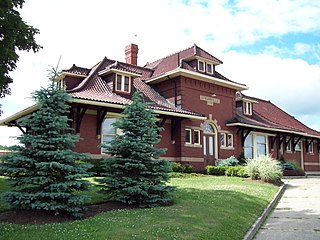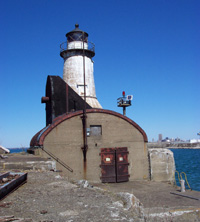
The Mentholatum Company, Inc. is a maker of non-prescription health care products founded in 1889 by Albert Alexander Hyde in the United States. It was bought out by Rohto Pharmaceutical Co., a Japanese health care company, in 1988. The Mentholatum Company is known for its top three products, Mentholatum Ointment, Mentholatum Deep Heating Rub, and Mentholatum Lip Care. The Mentholatum Building in Buffalo, New York was listed on the National Register of Historic Places in 2017.

The Buffalo Electric Vehicle Company was an American electric car manufacturing company from 1912 until 1915 located at 1219-1247 Main Street in Buffalo, New York. The motorcars were marked under the Buffalo brand. The company was formed by a merger of several electrical vehicle and allied companies which included:

Electric Tower is a historic office building and skyscraper located at the corner of Washington and Genesee Streets in Buffalo. It is the seventh tallest building in Buffalo. It stands 294 feet (89.6 m) and 14 stories tall and is in the Beaux-Arts Classical Revival style. It was designed by James A. Johnson and built in 1912. The tower was based upon an earlier Electric Tower constructed for the 1901 Pan-American Exposition; as with most of the buildings constructed for that event, the original was only temporary and demolished shortly after the fair ended. Additions were made in 1923 and 1928. The white terra-cotta clad was originally built as the Niagara Mohawk Building and features an octagonal tower which steps back three times to terminate in a large lantern. It is also known as Iskalo Electric Tower, for the real estate development company that owns the building.

James Addison Johnson was an American architect known for his design of various architectural landmarks in Buffalo, New York, and his use of decorative work that many consider a foreshadowing of art deco design.

Springville station is a historic train station located at Springville, Erie County, New York. It was built in 1910 by the Buffalo, Rochester and Pittsburgh Railway, and is a 1 1/2-story, rectangular brick building with a hipped roof. It consists of a central two-story tower section flanked by wings.

Herschell Carousel Factory Museum is a historic carousel factory building located at North Tonawanda in Niagara County, New York. The factory complex was constructed between about 1910 and 1915 and consists of six primary structures and five contributory additions. The primary structures are: the Mill Building, Carving and Pattern shop, Paint Shop and Storage Building, Roundhouse, Machine Shop (1915), and Assembly and Testing Building (1915). Also on the property is the Special Number One Three Abreast portable carousel, built in 1916.

First Unitarian Universalist Church of Niagara is a historic church located at Niagara Falls in Niagara County, New York. It was constructed in 1921–1922 in a Classical Revival style. The steel and concrete church is faced with rough, uncut limestone from the bedrock excavated for the building's foundation.

Annunciation School is a historic parochial school building located at Buffalo in Erie County, New York. It was built in 1928 and is an "I" shaped brick structure representative of standardized, modestly sized school buildings of the period. It was operated by the Sisters of St. Mary of Namur. The school was closed as a parish school in 1988. It was home to the Catholic Academy of West Buffalo until 2005 and was converted to apartments in 2009–2010.

Connecticut Street Armory, also known as the 74th Regimental Armory, is a historic National Guard armory building located at Buffalo in Erie County, New York. It is sited at Columbus Park. It is a massive castle-like structure built in 1899 of Medina sandstone. It was designed by architect Isaac G. Perry. It consists of a 3+1⁄2-story administration building with an attached 2-story drill shed all constructed of sandstone, lying on a rusticated battered stone foundation. The building features 4- to 6-story towers surrounding the administration building, and a 6+1⁄2-story square tower at the center entrance. It is home to the 74th Regiment of the New York National Guard. Prior to its construction, the site was home to a 13.5 million gallon reservoir.

Engine House No. 28 is a historic fire station building located at Buffalo in Erie County, New York. It is a Queen Anne style structure built in 1897.

Pierce Arrow Factory Complex is a national historic district consisting of the former Pierce-Arrow automobile factory located at Buffalo in Erie County, New York. Located over a 34-acre (14 ha) site, it consists of a three-story, 132,970-square-foot (12,353 m2) Administration Building and an assortment of automobile manufacturing and assembly related structures. The buildings are principally constructed of reinforced concrete, and the Administration Building is considered one of the two earliest fully realized examples of the Daylight Factory industrial architecture style. It was designed by Albert Kahn in about 1906 and served as the headquarters and production facility for Pierce-Arrow automobiles until 1938. Since then, the complex has been subdivided over the years to provide affordable space for many small companies and organizations. At one time local department store chain AM&A's operated a furniture warehouse in part of the complex.

Trico Plant No. 1 is a historic windshield wiper factory building located in Buffalo, New York. It is an example of a style of architecture sometimes referred to as the daylight factory, a style for which Buffalo is well known. The building was mostly constructed in the 1920s and 1930s of reinforced concrete and features curtain walls of metal sash windows and brick spandrels, although a portion of the plant incorporates an historic brewery building from the 1890s. It was the original home of Trico Products Corporation, the first manufacturer of windshield wipers, and was an important factory during a period when Trico was the largest employer in the city of Buffalo. The building is also known for once being the office of John R. Oishei (1886–1968), the company's founder and an industrialist who went on to become one of the most important philanthropists in the Buffalo Niagara Region.
Duane Lyman (1886–1966) was an architect based in Buffalo, New York, known for his prolific career which included 100 school buildings, many churches, and numerous large homes both in the city and suburban communities. At the time of his death, Lyman was referred to as the "dean of Western New York Architecture."

Buffalo Harbor South Entrance Light, also known as the South Buffalo Southside Light or Buffalo South Breakwater, South Entrance Light Station, is a lighthouse at Stony Point at the entrance to Buffalo Harbor, Buffalo, New York. It was established in 1903 and deactivated in 1993. It was replaced by a nearby modern post light. The lighthouse property consists of a three-story cast iron 43.5-foot (13.3 m) decommissioned light tower topped with a lantern; one-story concrete fog signal building and an L-shaped concrete pier.

Buffalo North Breakwater South End Light is a lighthouse formerly located at the entrance to Buffalo Harbor, Buffalo, New York. It is one of two "bottle shaped" beacons located in Buffalo Harbor; the other is the South Buffalo North Side Light. It is a 29-foot (8.8 m) high beacon constructed of boiler plate. It measures 10 feet 3⁄4 inch (3.067 m) at the bottom and 2 feet 3 inches (0.69 m) at the top. It is distinguished by four cast iron port windows and a curved iron door. It was first lit on September 1, 1903, and originally equipped with a 6th-order Fresnel lens. A battery operated 12 volt lamp with a 12 inches (300 mm) green plastic lens was installed in the beacon c. 1960, when a domed roof formerly mounted over the lens was removed. The beacon was removed in 1985, and now stands on the grounds of the Buffalo (main) Light. Its twin is located at the Dunkirk Lighthouse and Veterans Park Museum.

E. & B. Holmes Machinery Company Building, also known as The Cooperage, is a historic factory building located at Buffalo in Erie County, New York. It is a roughly rectangular brick building composed of three primary sections of four-, three-, and two-stories, which encircle a central courtyard. The three sections are the Mill Building, Forge Building, and Pattern Building (1913). The E. & B. Holmes Machinery Company revolutionized the barrel making industry by patenting the design and manufacturing of machinery used for mass-producing barrels. The company operated from 1840 until 2002.

Buffalo Trunk Manufacturing Company Building is a historic factory and warehouse building located at Buffalo in Erie County, New York. It is a five-story, eight bay, red brick, "L" shaped, flat roofed industrial building constructed in two phases, 1901–1902 and 1906–1907. It is an example of "slow burn" masonry and wood factory construction.

Alling & Cory Buffalo Warehouse is a historic warehouse building located at Buffalo in Erie County, New York. It consists of a six-story, "L" shaped, 120,000-square-foot (11,000 m2) former paper warehouse building built in 1910-1911 for the Alling & Cory company of Rochester, with a one-story, brick loading dock addition built in 1926. It is built of reinforced concrete with classical detailing and considered to be of the "Daylight Factory" design. The building has been rehabilitated into an apartment complex.
Esenwein & Johnnson was an architectural firm of Buffalo, New York.

F.N. Burt Company Factory is a historic former box factory complex located at Buffalo in Erie County, New York. Another factory operated by F.N. Burt in Buffalo was the F.N. Burt Company Factory "C".






















